Hello, friends welcome to the new post. In this post, we will have a look at What Size Wire for 100 Amp Service. Do you need to switch to a 100-amp electrical service? Different parts must be considered such as the size of the wire. for the electrical system to work accurately and in a safe condition choose the appropriate wire for what is needed. In this post, we will learn different components to get the proper wire size for a 100-amp service. So let’s get started with What Size Wire for 100 Amp Service
Introduction Size Wire for 100 Amp Service
The size of the wire is the main parameter in an electrical system to prevent different issues such as voltage loss and overheating conditions. To make sure the electrical load is working understanding control conditions and following the safety measures there must be a required wire for a 100 amp service to be used
What is Electrical Wire
it is good to follow the basic ideas of electrical wire before getting the technical functionalities of wire. Copper it aluminum are conductors used to make teh wires that are used to transfer the curent from the power source to different devices connected to circuits.
Related: How Many Lights on a 15 Amp Circuit
Factors to Consider
Wire Size and Ampacity
It feature of wire to tell how much current it can handle without getting overhead is called the capacity of write. High ampacity will have a larger wire size. It must be confirmed that wire size can support the highest load value for 100-amp service without overheating.
Conductor Material
The commonly used material for wire is copper and aluminum. Copper is mostly used for residential wiring since it is a high conductive material and aluminum is used for larger scale installation due to its higher and lower cost, mostly used in power transmission lines. The conductive material must be used on the base of project requirements distance and expenses
Voltage Drop
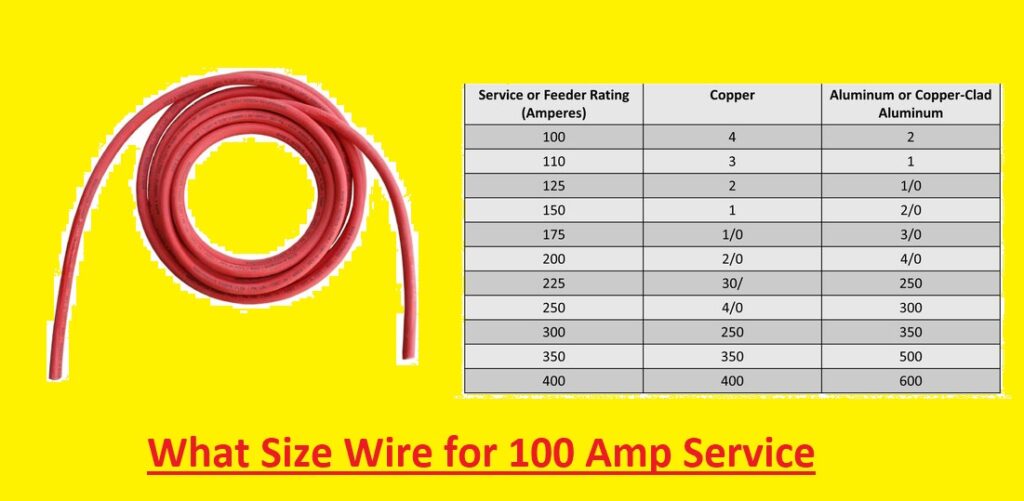
Voltage loss occurs when the curent passes through the wire. The bad electrical operation can cause high voltage loss, especially for longer-length wires. To minimize the voltage loss load and connection must be under control so it can’t take extra extra to causes the voltage losses
Wire Gauge Selection
The diameter of the wire is measured based on a wire gauge. The small gauges used for range were sizes that mean wire size and gauge inverse relation. To have accrued wire handling the load the wire must be according to voltage loss, distance covered, and ampacity
Common Wire Sizes
For 100 amp service wire sizes are 2/0 AWG, 1/0 AWG, and 4/0 AWG if the conductor used is alumni, and for cooper material wire sizes 3/0 AWG, 2/0 AWG, and 4/0 AWG also the same. The ampacity value must be between these values to maintain the proper working of a 100 amp load.
Types of Wire Insulation
To protect the wire from electrical problems and weather conditions there is the insulation used. Normally PVC, THHN, and (Cross-linked Polyethylene High Heat-resistant Water-resistant) XHHW are commonly used types of insulation.
Copper vs. Aluminum Wiring
We can use of copper and aluminum wiring for wire for a 100-amp service. Since they are reliable and come in good condition features, copper i used at small-level insulation and aluminum at larger size installation. To ensure proper safety there is a need for correct connection and antibody substances for aluminum wire.
Read also: 125 Amp Wire Size and Breaker Guide
What Size Wire for 100 Amp Service
Wire type and length of working area defined the wire size for 100 amp service. The normal wire size for 100 amp services in the USA is 2/0 AWG or 3/0 AWG.
100 Amp Wire Size Chart
| Wire Gauge (AWG) | Copper Wire Size (in mm²) | Aluminum Wire Size (in mm²) |
|---|---|---|
| 2/0 | 67.4 | 53.5 |
| 3/0 | 85.0 | 67.4 |
| 4/0 | 107.2 | 85.0
|
What size wire do I need for a 100 amp sub panel?
Normal wire sizes of 100 Amp Service are 1/0 AWG for aluminum or copper-clad wiring or 4 AWG or 2 AWG for copper wiring and 2 AWG, 1 AWG,
What Size Wire Should I Use for a Sub-Panel?
The highest ampere value of the subpanel and the distance between the main panel and the subpanel define the wire used for the subpanel. the National Electrical Code offers recommendations for wire size.
Following are instructions for subpanel amperage ratings:
- 60 amp subpanel: wire size is 6 AWG copper or 4 AWG aluminum wire.
- 100 amp subpanel: 1/0 AWG aluminum wire. or 2 AWG copper
- 200 amp subpanel: 3/0 AWG copper or 4/0 AWG aluminum wire.
What size wire do I use for 100 amp?
The normal wire size for 100 amp service is 4AWG or 2 AWG for copper wiring and 2AWG, 1 AWG, or 1/0 AWG for aluminum or copper-clad wiring. These wire sizes can also used for direct burial. The 100 amp circuit for 240 volts can handle 24,000W of electricity
Can I Run a 100 Amp Sub Panel from a 100 Amp Panel?
- Main Panel capacity: Confirm that the main panel comes with such an amount of power to handle the need for the sub-panel and the existing circuits. Before installing a sub-panel, if there is any modification needed in the main panel to handle the capacity must be updated.
- Wire Size: There must be required size for a 100 amp load from the main panel to the subpanel is needed.
- Breaker Size: There must be a circuit breaker Connected to the protection of panels and wire from electrical faults. there 100 amp breaker can be used in the main panel to handle the subpanels that carry 100 amps current
- Load Calculation: The connected load with the subpanel must be in the controlled value. Differnt loads must be connected with different ratings such, as lights, and appliances.
What to Do if Your Circuit Breaker Won’t
Wire Size For 100 Amp Sub Panel 100 Feet Away
- For copper wire:
- 2 AWG: it is used for a 100 amp subpanel connected 200 feet away.
- 1 AWG: Best for a 100 amp subpanel existing at 250 feet away.
- For aluminum wire:
- 1/0 AWG: it is used for a 100 amp subpanel about 150 feet away.
- 2/0 AWG:200 feet away. connected 100 amp subpanel USD this wire
Will 6 Gauge Wire Handle 100 Amps?
No, the 6 gauge wire does not have such a design to handle a 100 amp continuous load. The 6 gauge copper wire is designed to handle the highest ampacity of 55 amp according to NED. So it cannot handle 100 amp loads. Normally 2 gauge copper wire used for 100 amps
What Size Wire is Good for 100 Amps?
The best wire size for a 100 amp circuit is copper wire in the 2 AWG range. Wire capacity for homes-based applications can handle a load of about 100 amps.
How Many Amps is 6 AWG Good for?
The maximum ampacity for copper wire in 6 AWG is 55 amps. It can have a load value of 55 ampers in normal conditions
Can 8 Gauge Wire Handle 100 Amps?
No, 8 gauge wire can’t be used to handle a 100 amp continuous load. The highest capacity for 8 gauge copper wire according to NEC is 40 amps so it not be used to handle 100 amp circuits. In the case of a 100 amp circuit large size is required 2 gauge copper wire is used for 100 amp loads
How Many Amps is a 4 AWG Cable?
The copper wire in 4 AWG can have 85 amps ampacity. So it can used to work wor loads or 55 ratings
Where Can I Use a 100 Amp Service?
- Small homes: it is good for small houses that are less than 2,000 square feet in size. In these homes, there is different appliances such as washers and sued that operate on 240 volts without air conditions
- Detached garages: it is used for detached garages that come with heavy-duty devices like a power saw or welders.
- Agricultural facilities: it is used for agricultural fields to deliver power to a milking machine or a grain dryer.
How Many Wires Do You Need For 100 Amp Service
There are 3 wires for a 100 amp service. These wires are:
- 2 hot wires: They are used to handle the current from the service panel to devices connected
- 1 neutral wire: electrical current back to the service panel sent through this wire
- 1 ground wire: It is used to provide a path for the flow of short circuit currents.
Where is 100 AMP Service Used?
100 AMP service is used in different types of applications that are
- Residential homes:
- Temporary power at construction sites:
- Apartments and condos:
- Detached garages and workshops:
- Agricultural facilities:
- Subpanels and circuit breaker panels:
appliances and devices that can be powered with 100 AMP service:
- Air conditioner (up to 3 tons)
- Refrigerator
- Television
- Computer
- Lights
- Ceiling fans
- Exhaust fans
- Sump pumps
- Garage door openers
- Freezer
- Dishwasher
- Range
- Clothes dryer
- Water heater
- Washing machine
- Microwave oven
Types Of Wire Used in 100 Amp Service
These types of wire can be used in 100 AMP service
- Copper: it is a very common wire used in electrical applications, like 100 AMP service. Copper is a good conductor of electricity
- Aluminum: It can be used in 100 AMP service. Aluminum is more expensive than copper but its conductive nature is less than copper and its handling features are also more difficult than copper
- Copper-clad aluminum: Copper-clad aluminum wire comes with a copper core and an aluminum external layer. Costly than copper but its prices are also higher than aluminum but can easily handle aluminum
wire types that can be used in 100 AMP service:
- THHN: Thermoplastic High Heat-resistant Nylon-coated wire
- USE: Underground Service Entrance cable
- SER: Aluminum Service Entrance cable
- THWN-2: Thermoplastic High Heat-resistant Nylon-coated wire with a flame-retardant outer jacket
- XHHW: Cross-linked high Heat-resistant Water-resistant wire
- UF-B: Underground Feeder and Branch-circuit cable
- Type MC cable: Metal-clad cable
Types of Copper Wire For 100-amp Service Panels
| Type of copper wire | AWG size | Ampacity |
|---|---|---|
| THHN | 4 | 85 |
| THWN-2 | 4 | 85 |
| XHHW | 4 | 85 |
| USE | 4 | 85 |
Types of Aluminum Wire For 100-amp Service Panels
| Wire Type | Insulation Type | Applications |
|---|---|---|
| THHN | Thermoplastic high-heat nylon | Indoor dry conditions |
| THWN-2 | Thermoplastic high-heat nylon with weather-resistant coating | Indoor/outdoor both dry and wet locations |
| XHWW | Cross-linked polyethylene | direct burial in Indoor/outdoor dry and wet locations, |
| XHWN-2 | Cross-linked polyethylene with weather-resistant coating | direct burial and Indoor/outdoor dry and wet locations, l |
| USE-2 | Underground service entrance cable | Underground service |
| UF-B | Underground feeder cable | Underground feeder |
Will 100-Amp Service Be Sufficient for My Home?
These factors define whether it is sufficient for your home or not
- Area of home or size
- People living
- Devices used in the home
- power demand
- In general, a 100-amp service panel is enough for small-sized homes that have less number of devices connected. such as air conditioners, gas heating, and some lights or bulbs. But cannot handle larger size homes
high-wattage appliances that try to avoid the use
- Electric range and oven
- Electric water heater
- Electric clothes dryer
- Central air conditioning
- Hot tub
- Electric vehicle charger
If there are more than larger devices or all at the same time it can overload the 100-amp service panel.
Read Also
- 30 Amp Wire Size: What AWG Wire You Need?
- 125 Amp Wire Size and Breaker Guide
- 60 Amp Wire Size – Which AWG is Best for 60 Amp Breaker
- What Size Wire for 100 Amp Service
FAQ
1. Can we use a smaller wire size for a 100 amp service?
Ampcity defines the wire size used with the use of les swire size that is not suggested can cause overheating and other issues
2. Can we use aluminum wire for a 100 amp service?
Yes, aluminum wire is a workable 100-amp service.
3. How can we calculate voltage drop for my wire size?
Voltage loss calculations use different parameters like connected load wire length and conductor martial, . V=IR formula used for voltage
4. Can we install the wiring for a 100 amp service myself?
it can be complicated and hazardous. must get the services of professional engineers and technology to connect 100 amp service
- What size wire do I need for a 100 amp panel?
In the case of copper two AWG wires are used for 1 AWG used for aluminum
- What wire size for the 200 amp service?
6 AWG wire for copper and 4 AWG wire in case of aluminum.
- What is the minimum size of ground wire for a 100 amp service?
8 AWG copper wire or a 6 AWG aluminum wire is the minimum size of ground wire size
- How many amps can you put on a 100-amp service?
yes, we can connect 100 amps maximum on a 100 amp service.
Can I Use 4 Wire For 100 Amp Service?
No, you cannot use 4 wires for 100 amp service. According to the NEC code wire size for 100 amp service is 2AWG for copper and for alumina is 1 AWG. There is 70 amp curent that can handle by 4 wires in air-free conditions or 55 amper curent during runway conditions.
How Many Amps Will A 4 Wire Carry?
the ampacity of #4 wire in different conditions:
| Condition | Ampacity |
| Free air | 70 amps |
| Raceway | 55 amps |
| Direct burial | 65 amps |
| Watertight conduit | 50 amps |
- What wire do I need for a 100 amp sub panel?
A 4 AWG copper wire or 2 AWG aluminum wire l.
- What wire size for 200 amp service?
4/0 AWG aluminum wire or A 0 AWG copper wire
- What size wire for 150 amps?
0 AWG aluminum wire or 2 AWG copper wire size for a 150 amp circuit.
- What size wire for 80 amps?
2 AWG aluminum wire or A 4 AWG copper wire.
- What gauge wire for 50 amp 220V?
4 AWG aluminum wire or A 6 AWG copper wire
- Is 100 amp service enough?
It is based on the home size and connected devices in homes that define the 100 amp service is enough. If you have high-power devices like AC it is not good
- Can I run 50 amps to a 100 amp sub panel?
Yes, we can run 50 amps to a 100 amp sub panel. brekar in the panel must hage 50 amper rating
- What is 100 amp service?
A 100 amp service is the electrical service that helps to transfer power from the company to our house
- What happens if wire gauge is too big?
it makes the costly and large size difficult to connect and handle
- What size conduit do I need for 100 amp service?
Teh size is based on the type of wire For copper wire, it needed to 1-inch conduit. For aluminum wire, use a 1.5-inch conduit.
- What size wire do you need for 70 amps?
1 AWG aluminum wire or A 3 AWG copper wire
- What size wire for 180 amps?
A 1 AWG copper wire or 0 AWG aluminum wire
- How do you calculate wire size?
For this calculate the circuit ampere value length or run and wire type
- What is a 100 amp MCB used for?
A 100 amp MCB (Miniature Circuit Breaker) is used to protect a circuit from overloading and short circuits.
- How many volts is a 100 amp service?
A 100 amp service can be 120 volts or 240 volts. voltage value based on the area
- How many circuits does a 100a panel have?
A 100a panel can connect 10 to 20 circuits according to need
- What size wire for 300 amps?
A 0 AWG copper wire or 4/0 AWG aluminum wire
- What size wire for 50 amps?
A 6 AWG copper wire or 4 AWG aluminum wire size
- What size wire for 400 amps?
0 AWG aluminum wire or 2 AWG copper wire or
- How many amps is 1 mm wire?
The type of material and length of run define the value of the amp
- What size is 40 amp wire in MM?
A 40 amp wire is 6.35 mm in diameter.
- What is the standard wire amp?
The standard wire amp is 12 AWG. it is commonly used for household circuits
- Can you convert 100 amp to 200 amp?
Yes, it is possible 100 amp service to a 200 amp service. However, needed expert skills
- How many watts is 100amp?
Voltate defines the number of watts that a 100-amp circuit can provide. At 120 volts, a 100-amp circuit can deliver 12,000 watts. At 240 volts, a 100-amp circuit has 24,000 watts.
- Can 4 wire carry 100 amps?
Yes, 4 wires can carry 100 amps. Size and configuration must be accurate
- What size wire for 250 amps?
A 2 AWG copper wire or 0 AWG aluminum wire
- What size wire for 40 amps?
4 AWG aluminum wire size or A 6 AWG copper wire or
- Can 1.5 ton AC run on 2.5 mm wire?
Yes, a 1.5-ton AC can run on a 2.5 mm wire. However, it is good to make sure that the wire has the proper size and is connected accurately and it must be copper and at least 14 AWG.
- Which wire is used for 1.5 ton AC?
A 2.5 mm copper wire is normally used for a 1.5-ton AC. However, it is important to discuss with an electrician to find the correct wire size for your certain AC unit.
- What is 4mm wire used for?
A 4mm wire can be used for different applications, like running a 2-ton AC, a dryer, or a stove. It is good to make sure that the wire is properly sized and installed for certain applications.
- Which MCB is best for 1.5 ton AC?
A 15 amp MCB is the best for a 1.5 ton AC. it makes sure that the AC unit has enough power to operate safely and efficiently.
- How many amps is 1.5 ton AC?
A 1.5-ton AC uses 10 amps of current. but it is based on the model and company of ac
- What is the maximum load of 2.5 mm wire?
The maximum load of a 2.5 mm wire is 15 amps. 2.5 mm wire easily handles 15 amps of current.
- How many amps can 4 mm cable take?
A 4mm cable can carry 25 amps of current.
- How many amps is 1.5 mm cable?
A 1.5 mm cable can handle 10 amps of current.
- Can 4mm cable take 32 amps?
No, a 4mm cable cannot take 32 amps. The maximum load for a 4mm cable is 25 amps.


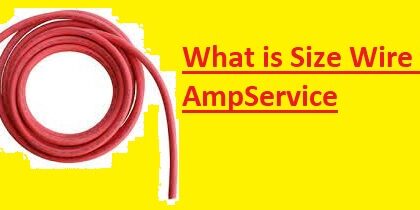
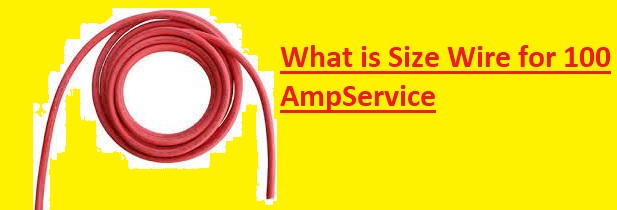
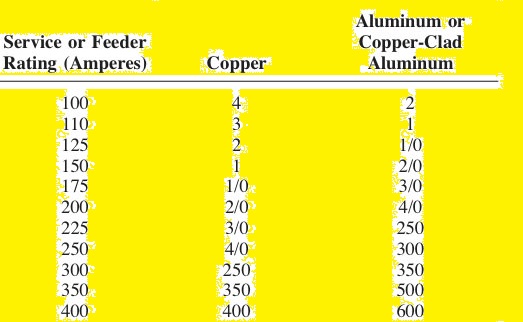
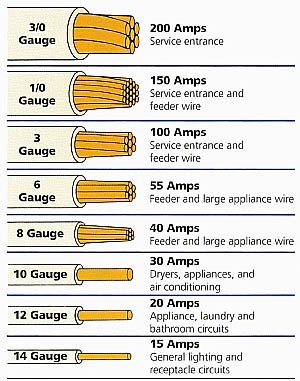
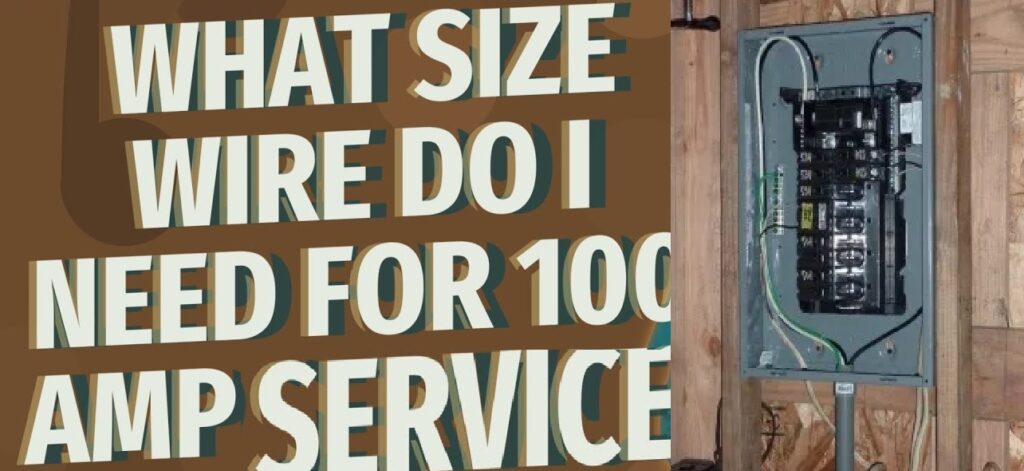





Small homes with predominantly gas appliances typically have a 100 amp service. Even though this amperage is the bare minimum required by regulation, careful preparation is still necessary to make temporary installations that are 300 feet away safe.